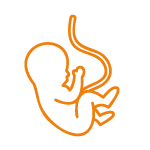Catheter explantation
If an effusion can no longer be drained, there are various reasons for this and, depending on the diagnosis, explantation of the catheter may be an option
- Due to successful treatment of the underlying disease, the water balance has normalized.
- A spontaneous pleurodesis has developed due to the recurrent drainages
- The effusion is septated, the catheter is located in a chamber
- Catheter occlusion that cannot be eliminated by flushing with NaCl or a fibrinolytic agent
If one of the above cases or another reason applies, the catheter can be explanted again.
Steps for removing the catheter
- Checking the coagulation parameters
- Preparation of a workplace under sterile conditions
- Positioning of the patient to ensure free access to the catheter
- Generous skin infiltration with local anesthesia at the catheter exit site (observe exposure time)
- Feeling the polyester cuff from the outside (bulging thickening)
- Incision of the skin, directly at the catheter exit site
- Blunt, circular, free preparation of the polyester cuff using a button cannula, dissecting scissors or similar (the catheter only grows together with the subcutaneous tissue at the polyester cuff)
- One hand is placed on the tunnel section as an abutment and the catheter is pulled out with the other hand.
- Close the former catheter exit site with a skin suture.
- Dress the wound.





